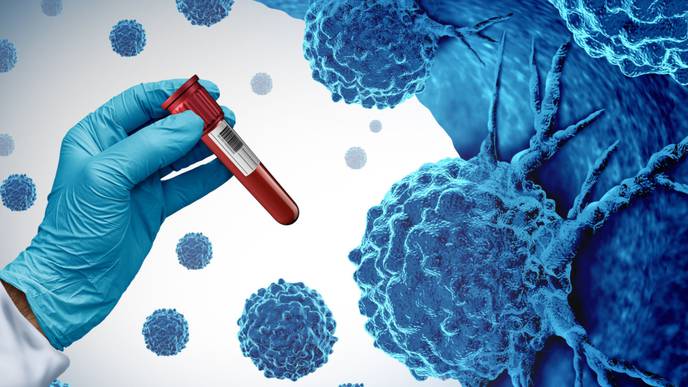Novel human Siglec-7 monoclonal and bispecific antibodies are being developed as potential future cancer immunotherapies
Philadelphia : The Wistar Institute’s David B. Weiner, Ph.D., executive vice president, director of the Vaccine & Immunotherapy Center (VIC) and W.W. Smith Charitable Trust Distinguished Professor in Cancer Research, and collaborators, have engineered novel monoclonal antibodies that engage Natural Killer cells through a unique surface receptor that activates the immune system to fight against cancer.

In their publication titled, “Siglec-7 glyco-immune binding MAbs or NK cell engager biologics induce potent anti-tumor immunity against ovarian cancers,” published in Science Advances, the team demonstrates the preclinical feasibility of utilizing these new cancer immunotherapeutic approaches against diverse ovarian cancer types, including treatment-resistant and refractory ovarian cancers — alone or in combination with checkpoint inhibitor treatment.
The research started as a collaboration between Wistar’s Drs. Weiner and Mohamed Abdel-Mohsen, who were exploring the development of new glyco-signaling biologic tools that may be important in the fight against cancer.
Ovarian cancer (OC) is frequently diagnosed late in the disease process, and OC resistance to currently available treatments make it especially problematic; according to the NIH, the chances of someone diagnosed with OC and surviving for five years is around fifty-fifty. Ovarian cancer demonstrates a low response rate to standard-of-care treatments like chemotherapies, PARP inhibitors and the widely used checkpoint inhibitor, PD-1.
In the small proportion of ovarian cancer patients that do respond to these treatments, resistance becomes problematic over time — resulting in tumor escape and cancer progression. Genetic mutations, such as the well-known BRCA gene mutations, predispose women to a high risk of progressive OC. The CDC expects more than thirteen thousand women to die of ovarian cancer this year in the U.S. alone.
To combat ovarian cancer treatment resistance, the team hypothesized that they might be able to engage not only the traditional T cell immune arm of the immune system which PD-1 and known checkpoint inhibitors (CPI) activate, but also implement a strategy to activate Natural killer cells (NK cells), a subset of important anti-tumor immune cells, through a conserved glyco-immune marker found on the surface of most NK cells called Siglec-7 (Sialic acid-binding immunoglobulin-type lectin). NK cells have been recently described to express Siglec-7, so the team tested two new strategies to engage and activate NK cells against ovarian cancer through Siglec-7.
The first approach used human monoclonal antibodies (mAb) discovered and developed at Wistar and novel assays to visualize and demonstrate that certain anti-Siglec-7 mAbs could activate human NK cells — which, in the presence of the antibodies, responded against multiple human OC cell lines. These now-activated NK cells would kill OC but not non-cancer cells with the Siglec-7 mAb treatment.
The researchers demonstrated that multiple OC carrying mutations, including BRCA1 and BRCA2, could be targeted by Siglec-7 antibodies through activated NK cells. The group moved to study the treatment of OC in a humanized mouse model and observed that the Siglec-7 treatment could impact OC growth slowing the tumors and increasing the animals’ survival.
Having demonstrated the feasibility of utilizing a Siglec-7 mAb in OC models, the team thought there were additional ways to use the Siglec-7 mAb to further focus on OC disease. They hypothesized that directly fusing the Siglec-7 reactive binding site of the Siglec-7 mAb to a second mAb that uniquely binds late OC through a molecule named Follicle Stimulating Hormone receptor (FSHR), which they had previously developed, would create a targeted Siglec-7 bispecific antibody that could bind through two distinct targets creating a new class of NK cell engagers (NKCE).
The team sought to test whether this Siglec-7 NKCE approach would be effective through the direct linkage of potentially killer NK cells to a guided missile aimed specifically at OC, which would open up a new path to develop additional Siglec-7 based immunotherapeutic approaches. In both bench and humanized mouse challenge studies, the Siglec-7-NKCE was effective at targeting OC, activating NK cells in local proximity and efficiently killing multiple OC.
Both Siglec-7 technologies (mAbs and NKCEs) demonstrated an ability to recruit and activate the NK cell population, shrink tumors and prolong survival in the models studied. The observation of on-target specificity of the approaches suggests that cancer’s apparent Siglec vulnerability can be exploited therapeutically, perhaps with limited toxicity — a promising sign for the future of anti-cancer Siglec research, but the team cautions that more work in this regard is important.
In an additional set of preliminary studies, the team also found that this Siglec-7 approach could complement PD-1 checkpoint inhibitor (CPI) therapy. This is an important area of further study that could uncover more details of the mechanisms involved and possibly extend the utility of such CPI in OC and, potentially, other cancers. “These findings open the door to further exploration of how we can engineer Siglec-7 immunotherapies and perhaps other related molecules for ovarian cancer and perhaps a larger group of recalcitrant cancers,” stated Dr. David B. Weiner, adding, “Further studies may bring such approaches as described to represent new tools in our antitumor toolbelt.”
As always, more research is needed to refine these technologies further on the long journey from the lab bench to the clinic. But this paper offers a different avenue for attempting to exploit these unique interactions of immune surface molecules such as Siglec-7 and perhaps other Siglecs.
“We have observed not one but two methods that can target NK cells in an effort to control ovarian cancer in both Petri dishes and in vivo models,” said Dr. Devivasha Bordoloi, the first author on the paper. “This research shows a lot of promise, and I’m excited to move these studies to the next steps.”
Co-authors: Devivasha Bordoloi, Abhijeet J. Kulkarni, Opeyemi S. Adeniji, Pratik S. Bhojnagarwala, Shushu Zhao, Candice Ionescu, Alfredo Perales-Puchalt, Elizabeth M Parzych, Xizhou Zhu, Ali R. Ali, Joel Cassel, Rugang Zhang, Mohamed Abdel-Mohsen and David B. Weiner of The Wistar Institute; and M. Betina Pampena and Michael R. Betts of Perelman School of Medicine, University of Pennsylvania,





